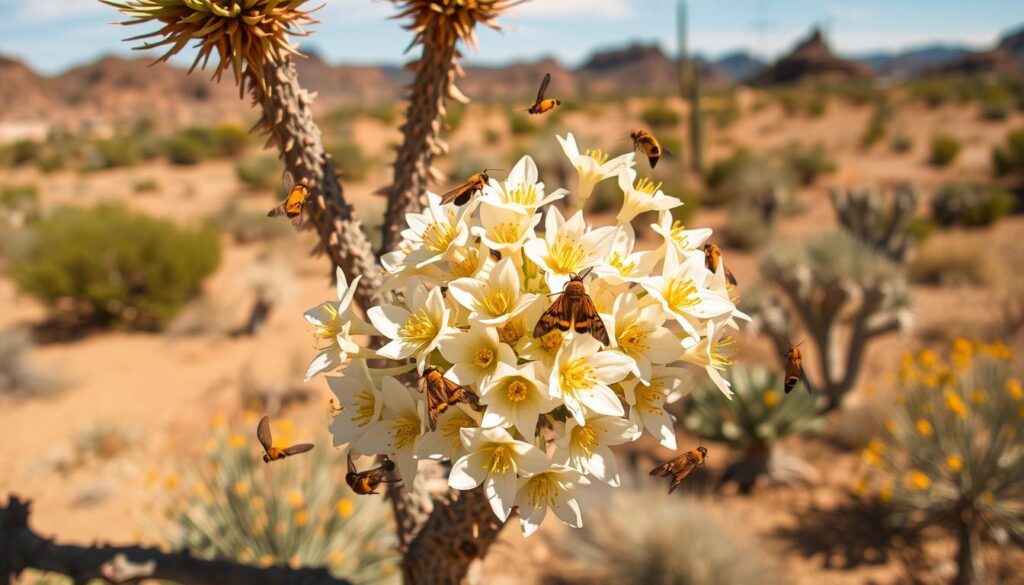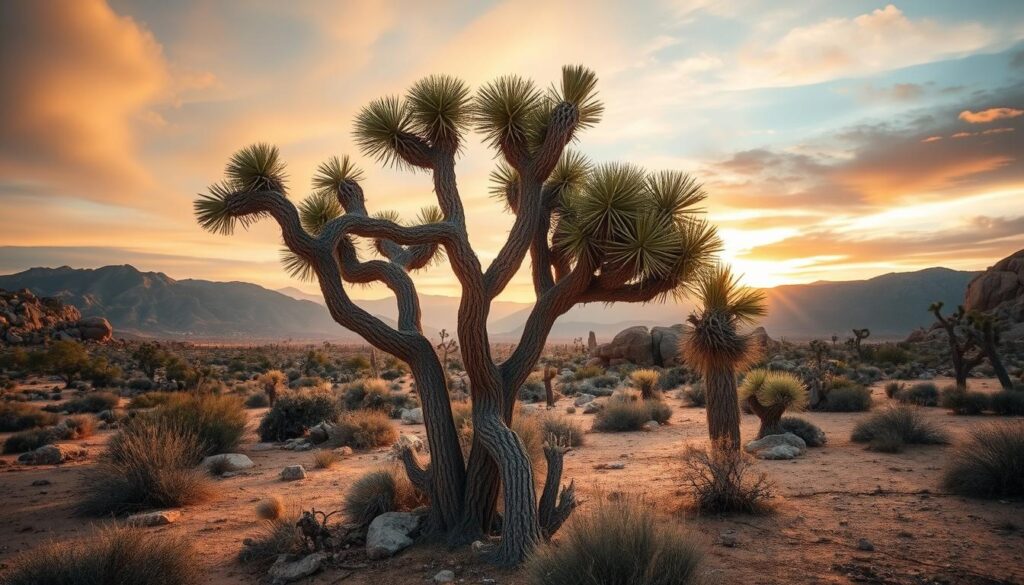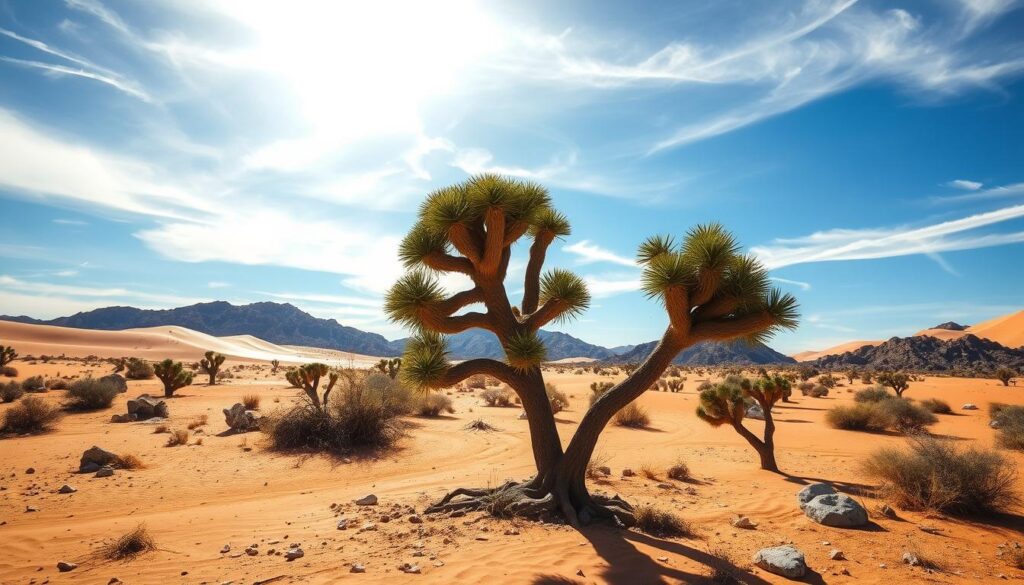A single wildfire in August 2020 destroyed over 1.3 million Joshua trees in the Mojave National Preserve. This shows how fragile these desert plants are. Joshua trees are symbols of the American Southwest, adapted to the harsh desert climate.
I find Yucca brevifolia, or Joshua trees, fascinating. They look like they belong in a Dr. Seuss story with their twisted branches and spiky leaves. These plants are vital in the Mojave Desert, helping many desert animals survive.
Despite their toughness, Joshua trees are under threat. Climate change, wildfires, and invasive species are harming them. Some scientists fear they could vanish from Joshua Tree National Park by 2100. This has sparked efforts to save them, like the Western Joshua Tree Conservation Act in California.
Key Takeaways
- Joshua trees are iconic xerophytes native to the Mojave Desert
- They face significant threats from wildfires and climate change
- Conservation efforts are underway to protect these unique desert plants
- Joshua trees can grow up to 40 feet tall and live for several centuries
- They play a vital role in the arid ecosystem of the American Southwest
Introduction to Yucca Brevifolia
I’m excited to introduce you to Yucca brevifolia, a fascinating plant from the Asparagaceae family. It’s known for surviving in dry places. Let’s explore its scientific name, common names, and where it grows naturally.
Scientific Classification and Taxonomy
Yucca brevifolia is in the Agavoideae subfamily of the Asparagaceae family. This group includes other plants that can live in dry places. It was first described by George Engelmann in 1871 and has since caught the interest of botanists and nature lovers.
| Kingdom | Order | Family | Genus | Species |
|---|---|---|---|---|
| Plantae | Asparagales | Asparagaceae | Yucca | Y. brevifolia |
Common Names and Their Origins
The Joshua tree is the most common name for Yucca brevifolia. This name came from Mormon settlers in the mid-1800s. Other names include yucca palm, tree yucca, and izote de desierto, which describe its tree-like shape and desert home.
Native Range and Habitat
Yucca brevifolia grows in the Mojave Desert, covering parts of California, Arizona, Utah, and Nevada. It can live at elevations from 400 to 1,800 meters. In some places, these plants grow together, creating a unique and beautiful landscape.
The Joshua tree is a symbol of toughness in the desert. It plays a big role in the Mojave Desert ecosystem. It also provides a home for many desert animals.
Physical Characteristics of the Joshua Tree
I’ve always been drawn to the unique look of Joshua trees. These iconic plants stand tall in the dry lands of the American Southwest. They show off amazing ways to save water. Let’s dive into what makes these plants so interesting.
Joshua trees have a tree-like shape with a special way of branching. Their trunks are fibrous and don’t have the yearly growth rings seen in other trees. The standout feature is their dark green, bayonet-shaped leaves. These leaves are 15 to 35 cm long and 7 to 15 mm wide at the base. They have serrated white edges and sharp tips.
One key adaptation of the Joshua tree is its spines. These modified leaves cut down on water loss and keep desert animals away. The spines are vital for saving water by holding moisture and creating a microclimate around the plant.
From February to late April, Joshua trees bloom with creamy white to green flowers in panicles. These flowers are key for the plant’s reproduction and draw in pollinators suited to the desert.
| Feature | Description | Function |
|---|---|---|
| Leaves | Bayonet-shaped, 15-35 cm long | Photosynthesis, water conservation |
| Spines | Sharp, modified leaves | Protection, moisture trapping |
| Trunk | Fibrous, no growth rings | Structural support, water storage |
| Flowers | Creamy white to green panicles | Reproduction, pollinator attraction |
The Joshua tree’s unique look makes it a wonder of the desert. Its ability to survive in harsh conditions shows how adaptable desert plants can be.
Growth and Development Patterns
I’m always intrigued by how xerophytes adapt to arid climates. The Joshua tree, or Yucca brevifolia, is a great example. These desert giants have amazing growth patterns that help them survive in tough conditions.
Growth Rates and Lifespan
Joshua trees grow quickly for desert plants. In their first ten years, they can grow about 3 inches each year. After that, they slow down to about 1.5 inches a year. These tough plants can live for hundreds of years, reaching heights of nearly 50 feet!
Unique Branching Structure
The way Joshua trees branch out is linked to their blooming. New branches grow after the tree flowers, which happens with the right amount of rain and winter freezes. This leads to their unique, often uneven shape.
Root System and Adaptations
The roots of Joshua trees are amazing at adapting to arid climates. They spread up to 36 feet from the trunk, helping them grab water from a wide area. This big network lets these xerophytes survive in the desert.
| Adaptation | Function |
|---|---|
| Wide-spreading roots | Maximize water absorption |
| Slow growth rate | Conserve energy and resources |
| Branching after blooming | Efficient use of resources for reproduction |
These adaptations show how Joshua trees have evolved to be desert experts. Their growth patterns prove nature’s cleverness in tough environments.
Joshua Tree Reproduction and Pollination
The way Joshua trees reproduce is really interesting. They need a special moth, the yucca moth, to help them pollinate. This shows how nature works together perfectly.
The yucca moth is key to the Joshua tree’s survival. Female moths carry pollen, sometimes as much as 10% of their body weight, from flower to flower. They also lay eggs in the flowers. This means their babies will have food when they come out.

Joshua trees don’t have nectar, so other pollinators don’t visit them. But the yucca moth is just right for the job. This relationship is called obligate pollination mutualism. It helps both the tree and the moth.
After pollination, Joshua trees grow fruits with many seeds. These fruits are green-brown and shaped like an ellipse. The tree can also make new shoots from its roots, without flowers.
When Joshua trees bloom is not regular. They need the right amount of rain and a winter freeze to bloom. This makes them even more special in the desert.
| Joshua Tree Reproduction Facts | Details |
|---|---|
| Primary Pollinator | Yucca Moth |
| Pollination Type | Obligate Pollination Mutualism |
| Fruit Characteristics | Green-brown, elliptical |
| Alternative Reproduction Method | Vegetative (via rhizomes) |
| Blooming Conditions | Well-timed rains, winter freeze |
Desert Plants: Yucca Brevifolia’s Role in Arid Ecosystems
The Joshua tree, or Yucca brevifolia, is a true survivor in the desert. It’s a key player in its harsh environment. This plant is essential for its ecosystem.
Importance as a Keystone Species
Joshua trees are crucial to their ecosystem. They offer homes to many animals. Birds and reptiles find shelter in their branches and trunks.
Their unique shape makes them ideal for the desert. This makes them a key part of the ecosystem.
Interactions with Wildlife
The relationship between Joshua trees and wildlife is interesting. A special moth pollinates these plants. The moth lays eggs in the flowers.
When the eggs hatch, the caterpillars eat some seeds. But they leave enough for new trees to grow. This balance is vital for nature.
Adaptation to Extreme Desert Conditions
Joshua trees are incredibly resilient. They can survive in extreme heat and cold. Some can even handle temperatures as low as -20°F!
Their roots spread wide to catch water. The trunks are full of fibers that help move water and food. These features let them thrive where other plants can’t.
| Adaptation | Benefit |
|---|---|
| Fibrous trunk | Efficient water transport |
| Extensive root system | Better water absorption |
| Temperature tolerance | Survival in extreme heat and cold |
Climate change threatens Joshua trees. It’s harder for young trees to grow. But these amazing plants keep fighting to survive in their harsh desert home.
Historical and Cultural Significance
I’ve always been drawn to the rich history of Yucca brevifolia, known as the Joshua tree. Native American cultures have valued this plant for centuries. The Cahuilla people used its leaves for baskets and sandals. They also ate its flower buds and seeds.
The tree’s history is also tied to Mormon settlers in the Southwest. They saw its branches as like Joshua from the Bible, leading them in prayer. This led to the name “Joshua tree” we use now.

Early settlers, including Mormons and ranchers, found many uses for the Joshua tree. They used its strong trunks and branches for fences and fuel. This shows how the tree helped people survive in the desert.
“The Joshua tree stands as a living testament to the resilience of both nature and human spirit in the face of adversity.”
| Group | Use of Joshua Tree |
|---|---|
| Cahuilla People | Baskets, sandals, food source |
| Mormon Settlers | Spiritual symbol, fencing material |
| Ranchers | Fuel source, construction material |
Today, the Joshua tree still amazes people and researchers. It symbolizes the American Southwest and our bond with nature.
Conservation Status and Threats
The Joshua tree is facing big challenges in the wild. Climate change, wildfires, and invasive species are all threats to its survival. I’ve seen how these issues affect desert ecosystems in Joshua Tree National Park.
Climate Change Impacts
Climate change is a big threat to Joshua trees. Rising temperatures and changes in rainfall patterns stress these desert plants. Scientists think there could be a 90% reduction in their range by 2100. This could make the species endangered.
Wildfires and Invasive Species
Wildfires are happening more often and getting worse in Joshua tree areas. These fires, often started by invasive grasses, can destroy Joshua tree populations. Seeing the aftermath of these fires is sad, with many Joshua trees left charred.
Conservation Efforts and Legislation
There are efforts to save Joshua trees. The Western Joshua Tree Conservation Act in California aims to protect the species while allowing some development. But, the future of Joshua trees is still uncertain.
| Species | Conservation Status | Population |
|---|---|---|
| Joshua Tree | Vulnerable (NatureServe) | 90% range reduction predicted |
| Arizona Hedgehog Cactus | Endangered | 250-1,000 individuals |
| Golden Barrel Cactus | Endangered (IUCN) | ~11,000 in the wild |
The struggle of the Joshua tree shows the challenges faced by desert species. Protecting these plants means tackling climate change and preserving habitats. This is key to saving our unique desert ecosystems.
Joshua Tree National Park: A Protected Haven
I’ve always been drawn to national parks, and Joshua Tree National Park is a standout for desert conservation. It was created on October 31, 1994, covering 792,510 acres. This park is a key place for the Mojave Desert’s unique ecosystem.
The park’s western half is above 3,000 feet, right in the heart of Joshua tree country. These trees can live over 300 years, making them some of the oldest in the American southwest desert. However, climate change could make them lose up to 90% of their home in the next century.
But Joshua Tree National Park is more than just about the trees. It’s where the Colorado and Mojave deserts meet, creating a hotspot of biodiversity. You’ll find lush fan-palm oases and many bird species that live in Joshua trees. There are also lizards and mammals that depend on these plants for survival.
Every year, 2.8 million people visit, including 300,000 rock climbers. Yet, the park faces big challenges. Scientists say Joshua trees could all but disappear by the end of the century because of climate change. That’s why it’s vital to keep working on conservation and protecting this desert gem for the future.
FAQ
What is the scientific name of the Joshua tree?
Where is the native range of the Joshua tree?
How tall do Joshua trees grow?
How long can Joshua trees live?
What is unique about the Joshua tree’s branching structure?
How are Joshua trees pollinated?
Why are Joshua trees considered keystone species?
How have Joshua trees been culturally significant?
What threats do Joshua trees face?
Where can I see Joshua trees protected?
Source Links
- Yucca brevifolia
- Yucca brevifolia, Joshua Tree, Southwest Desert Flora
- Joshua tree, Yucca brevifolia – Biodiversity Atlas of LA
- Yucca brevifolia
- Joshua Tree – yucca brevifolia
- Plants – Joshua Tree National Park (U.S. National Park Service)
- Joshua Trees – Joshua Tree National Park (U.S. National Park Service)
- Microsoft Word – Document30
- Rooting in the Desert: A Developmental Overview on Desert Plants
- Pollinators of the Joshua Tree: Past and Present
- Reproductive ecology and stand structure of Joshua tree forests across climate gradients of the Mojave Desert
- Joshua Tree Botanical and Signature
- All about Joshua trees, a keystone species
- Types of Yucca Plants – Yuccas Care & Growing Guide| Planet Desert
- Desert Cultural Heritage – NigerHeritage
- Indian uses of desert plants
- No title found
- Rare & Endangered Species – Boyce Thompson Arboretum
- Conservation of Rare, Sensitive, and At-risk Desert Plant Species
- Saving the Joshua Tree
- Nine reasons to save the Joshua tree
- Park Archives: Joshua Tree National Park


